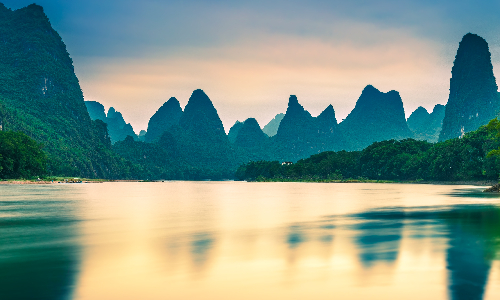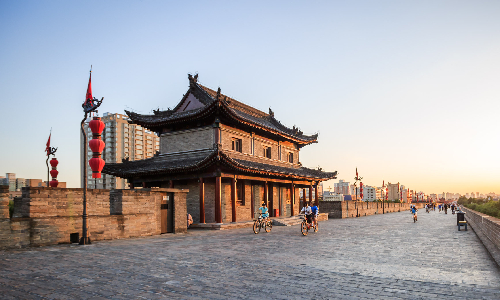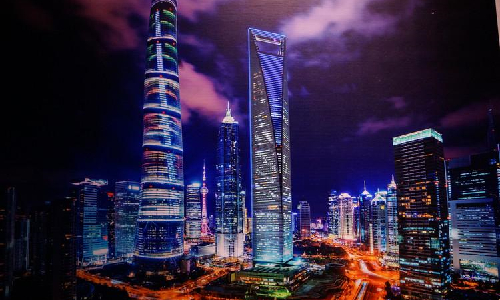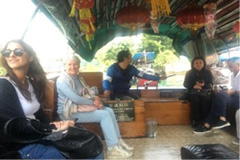Discover the Golden Triangle Cities of China on this best China tour from Hong Kong: you will fall in love with the best city in China, places so charming that you won’t want to go home! This 12-day Hong Kong, Guilin, Xi'an, Shanghai, Beijing tour is one of our best china tour packages, offering an incredible introduction to China. You will visit 5 diverse cities. You could explore the best of Hong Kong, Victoria Peak, on a Hong Kong day tour. In Guilin, you could take the opportunity to savor and photograph the best views of Li River on the best Li River cruise. In Xi'an, you can skip the ticket line to visit the UNESCO World Heritage Site-Xi'an terracotta warriors. With your guide, you could inspect the best of china tour, including the Forbidden City, the Great Wall, the Bund and Yu Garden.

Welcome to Hong Kong, China. This is the first city of your journey in China. Your local guide will pick you up at the airport and transfer you to your hotel for a rest. You just need to enjoy a wonderful journey we carefully arrange for you.
Hong Kong enjoys the reputation of “Pearl of the East”, “Gourmet Paradise” and “Shopping Paradise”. Besides its unique cultural heritage, ancient temples, fishing villages, and historical sites, the city is full of modern fashion elements. You will immerse yourself in the beautiful natural scenery and modern civilization in Hong Kong.
After breakfast, the guide will show you around Hong Kong for half the day. You will first go to Victoria Peak, the leading tourist attraction in Hong Kong. Standing on the top of the mountain, visitors can overlook the whole view of Hong Kong Island. The Peak Tower on the top of the mountain has a unique bowl shape, and its appearance is widely used in millions of postcards and photos around the world. In addition, there is an exhibition gallery, displaying precious photos of early Hong Kong. Visitors can see the changes in Hong Kong in the past century through these photos.
The most convenient way to go to Victoria Peak is to take the peak tram. The tram was opened in 1888, with a history of more than 130 years. It is one of the oldest tram systems in the world with a total length of 1,365 meters. This tram tour will only take about eight to ten minutes, but it will bring you an unforgettable visual experience. The tram climbs from 28 meters above sea level to 396 meters along the slope, shuttling through trees and high-rise buildings on both sides. When it arrives at the top of the mountain, the sight of Victoria Harbor will catch your eyes.
Among many famous fishing villages in Hong Kong, Aberdeen Fishing Village is the oldest one. It was a fishing village more than 100 years ago. Up to now, hundreds of fishermen still live here. New buildings and old communities in the village form a strong contrast and reveal the past and present images. Taking a sampan to experience the local life is memorable and you can take many beautiful scenery photos meanwhile.
Then your guide will take you to Stanley Market. It lies in Stanley, a beautiful town in the south of Hong Kong. The characteristics of Stanley are sunshine, sandy beach, Chinese and Western architectural style, and various shopping and dining centers. You will enjoy the gentle sea breeze, characteristic buildings along the street and taste the delicacies of open-air restaurants and street snacks. In the Stanley Market, you will find many souvenirs, such as shoes, clothes, ornaments, calligraphy and paintings, antiques, and other diversified products.
After visiting the above attractions, you will go back to the hotel and prepare for the tour in the next city.

 Guilin
Guilin After breakfast, you will be transferred to the train station and take an estimated train G408 12:05/15:25 to Guilin. Your local guide in Guilin will wait for you at the train station.
Guilin is located in the northeast of Guangxi Zhuang Autonomous Region. It is a world-famous city for its splendid views of various mountains, magnificent caves, and clear rivers, and it enjoys the reputation that “Guilin enjoys the best landscape in China”. It has a typical karst landform with beautiful scenery and unique geographical conditions.
 Yangshuo
Yangshuo Guilin
Guilin After breakfast, you will visit the Li River, a must-see scenic spot with a total length of about 83 kilometers. Taking Li River Cruise is the safest and most comprehensive way to enjoy the beautiful scenery of Li River. You will take the Li River Cruise from Guilin Mopanshan Dock or Zhujiang Dock and drift along the river to Yangshuo. The whole journey lasts about 4 hours. You will have lunch on the cruise ship. Along the way, the river twines various green mountains just like the blue color satin ribbon. Many attractions are along the river, such as Elephant Trunk Hill, Chuanshan Mountain, Douji Mountain, Mopan Mountain, and many unique caves. You will see the posture of mountains change constantly as the ship moves. In addition, the scenery of the Li River has different characteristics on different days. You will see the mountain scene reflect in the clear and tranquil river on sunny days. On rainy days, the mist fills the air like a fine gauze over the mountains and the river and the floating clouds pass through the strange peaks, leaving a marvelous picture.
After arriving in Yangshuo, you will go to visit Yangshuo West Street. Yangshuo West Street is the oldest pedestrian street in Yangshuo County. Founded in 1674, it is about 8 meters wide and nearly 800 meters long. The street is paved with local shiny marbles. Both sides are brick houses built in the Qing Dynasty (1636 - 1911) with white walls and red windows, revealing the simplicity and elegance of Lingnan (Lingnan refers to the area of Guangdong, Guangxi, Hainan, Hong Kong and Macau) architecture. These ancient buildings, such as the Ming City Wall, inscriptions, temples, pavilions, the residence of celebrities and memorial halls, are well preserved. Many Chinese traditional ornaments, such as cloisonne dyeing cloth, embroidered purses, Chinese knots of different styles, are placed in the stalls on the street. This street is also famous for bars, restaurants, and coffee shops with different styles.
After visiting Yangshuo West Street, it will take about 1.5 hours for nearly 80 kilometers to drive back to the hotel.


 Xi’an
Xi’an This afternoon, the tour guide will transfer you to the airport for you to take the estimated flight CA1472 16:30/18:25 to Xi’an, where a local tour guide will arrange your next trip.
Xi’an, together with Athens, Cairo, and Rome, is called the world’s four ancient capitals. It is the starting point of the ancient Silk Road, and a famous historical and cultural city. It has a history of over 7,000 years of civilization and is known as the “History Museum of China” with a total of 126 museums and abundant cultural relics. At present, six heritages including the Terra-cotta Warriors Museum, the Big Wild Goose Pagoda, the Daming Palace National Heritage Park, the Site of Weiyang Palace in Chang’an City of Western Han Dynasty, and the Xingjiao Temple Pagoda are listed in the World Heritage List. Luxuriant cultural and historical attractions will make you feel the profoundness of Chinese history and culture.
Option:
It is also a good choice to visit Reed Flute Cave in Guilin. It is located in the northwest of Guilin, 5 kilometers away from the city center. It is a scenic spot with caves as the main attraction. The tour of the 500-meter-long Reed Flute Cave takes about 40 minutes. There are a large number of exquisite stalagmites, stone pillars, stone curtains and stone flowers in the cave. Reed Flute Cave has not only marvelous natural scenery but also profound cultural heritage. There are more than 70 ancient murals in it, many of which have been the works of literati, monks, and tourists since the Tang Dynasty (618 - 907).
After a hearty breakfast, you will start your wonderful trip in Xi’an. This morning, we will drive for about 1 hour for 40 kilometers to the Lintong District of Xi’an, and visit the most famous relic in Xi’an, the Terra-cotta Warriors and Horses Museum. It is a large subordinate tomb built during the reign of Emperor Qinshihuang (259 BC - 210 BC), the first feudal emperor in China, for guarding the mausoleum of Qinshihuang. It is also the largest underground military museum in China and is known as “the eighth wonder of the world”. There are three large pits in the museum with more than 8,000 terra-cotta figures of over 2,000 years old. Pit No. 1, the largest one, hosts the main force of the army with chariots and infantry. Pit No. 2 is the essence of the pits and is composed of chariots, cavalry, and crossbowmen. Pit No. 3 is the smallest one. From the internal layout of this pit, it should be the command of pit 1 and 2.
The garrison force of the burial pits consists of different kinds of figures, such as officers, cavalrymen, saddled war horses, archers, and charioteers. The figures have different facial expressions, costumes, and gestures. In addition, a large number of burial objects are also found in the pits, such as stone armors and helmets, bronze bells, bronze cranes, pentagonal clay drainpipes and bronze shields, swords, spears, and other military equipment. The bronze weapons in the museum are still sharp-edged after more than 2,000 years, which shows a high metallurgical technology at that time. All those together build a massive treasure house. The mausoleum including the pits of Terra-cotta Warriors and Horses was listed as one of the UNESCO World Cultural Heritage Site on December 7th, 1987.
At lunchtime, the guide will show you the local cuisine to relieve your fatigue during the trip and you will get ready for the afternoon trip.
After visiting the Terra-cotta Warriors and Horses Museum, you will go to another world cultural heritage Big Wild Goose Pagoda. It takes about one and a half hours to drive from Terra-cotta Warriors and Horses Museum to Big Wild Goose Pagoda. Located in the Daci'en Temple, a Buddhism temple, the pagoda is a rare masterpiece in Chinese Buddhist architectural art and is the best choice for Buddhist believers. It is 64.5 meters high, with seven floors. According to historical records, in 645 of the Tang Dynasty, monk master Xuanzang brought back a large number of Buddha relics, hundreds of Sanskrit scriptures and eight gold and silver Buddha statues from ancient India. To enshrine and cherish these treasures, Xuanzang personally presided over the construction of the Big Wild Goose Pagoda.
Then you will continue to experience another religious building in Xi’an, the Great Mosque. This ancient Islamic mosque covers an area of over 12,000 square meters. The overall architectural layout consists of five courtyards. Each courtyard is designed in a quadrangle model. The main buildings are arranged along the central axis. After entering the mosque, you will pass through the wooden archway, stone archway, several halls, and buildings before reaching the largest building of the whole mosque where the worshippers pray. Holding over 1,000 worshippers at the same time, this largest building is completely in Chinese architectural style, while the decoration in the hall reflects the Islamic style.
Near the Great Mosque is the Muslim Quarter, the most famous snack street in Xi’an. Your tongue will be satisfied on this street. This street is full of restaurants and stalls, among which there are many time-honored shops most recognized by local people. Behind these stalls are restaurants that provide local snacks. Here you can taste Shaanxi food, such as roujiamo (bun stuffed with chopped pork, which resembles a Chinese hamburger), pieces of pancake in mutton soup, cold rice noodles, plum juice and bean paste cake.


 Shanghai
Shanghai On the last day in Xi’an, you will visit the ancient City Wall of Xi’an after breakfast. Xi’an City Wall is the largest and best-preserved ancient city wall in China. The existing city wall, with a total length of 13.7 kilometers, was built in 1370 and completed in 1378 during the Ming Dynasty (1368 - 1644). It includes military facilities such as the moat, suspension bridges, gate towers, arrow towers, and corner towers, which constitute a strict and complicated military defense system. There are four main gates, namely Changle Gate (East Gate), Yongning Gate (South Gate), Anding Gate (West Gate) and Anyuan Gate (North Gate). Up to now, there are 18 gates in the city wall. Among them, the South Gate is the major gate for ceremonies to welcome tourists. Sightseeing bus and bicycle rental services are provided on the city wall. The sightseeing bus circles around the city wall for about 50 minutes, or you can rent a bicycle and ride for about one and a half hours.
Your trip to Xi’an is coming to an end. We wish you a wonderful experience in Xi’an. The distance from the ancient City Wall to the airport is about 40 kilometers and it takes about 1 hour. Then you will take the estimated flight HO5728 18:00/20:25 to Shanghai. The local guide in Shanghai is waiting for you at the airport.


After breakfast, you will start your trip from Jade Buddha Temple. The temple is named after two big jade Buddha statues and it is one of the top ten attractions in Shanghai. Although it is located in a bustling urban area, it maintains tranquility. The temple covers an area of 8,856 square meters and is modeled after the temple style of the Song Dynasty (960 - 1279). There are more than 200 halls in the temple where all the buildings are arranged along the central axis. The central axis is lined with three halls: Grand Hall, Avalokitesvara Bodhisattva Hall and Heavenly Kings Hall.
Next, you will visit Yu Garden (closed each Monday). Yu Garden is a famous classical southern garden. First built in 1559 during the Ming Dynasty, it was a private garden at that time. The layout of the garden maintains the architectural style of the Ming and Qing Dynasties. After a long time of development, thousands of precious cultural relics, such as paintings, ceramics, brick carvings, stone carvings, wood carvings, clay sculptures and other delicate objects have been collected in Yu Garden. In addition, there are more than 40 scenic spots in the garden. It is not only a natural scenic spot for leisure and sightseeing but also an ancient site for understanding Chinese landscape architecture.
After visiting Yu Garden, the tour guide will take you to have lunch in a local restaurant. Then you will visit Shanghai Tower, which is located in the finance and trade area of Pudong District, Shanghai. The building has a total height of 632 meters with a construction area of 578,000 square meters. It is the first choice of global financial enterprises and service institutions to set up their regional headquarters. The world’s fastest elevator can take you to the 546-meter-high observatory on floors 118 and 119 where you will have a 360-degree bird’s eye view of Shanghai’s renowned buildings, natural beauties and the everchanging skyline.
The attraction that must not be missed in Shanghai is the Bund. Shanghai Bund is the most famous waterfront on the west bank of the Huangpu River. Here, you will feel the harmonious combination of classicism and modernism. Twenty-six buildings with different western architectural styles have made the Bund a “World Architecture Museum”. Along the Bund, you will enjoy a beautiful scene composed of European classical buildings with modern buildings. You can also see high-rise buildings on the opposite side of the Bund, such as Oriental Pearl TV Tower, Shanghai World Financial Center, Jin Mao Tower and Shanghai Tower.
Nanjing Road, also located in Huangpu District of Shanghai, is the right choice to experience the taste of old Shanghai. Nanjing Road is one of the bustling commercial streets in Shanghai where thousands of businessmen gather and you can buy almost any goods. The century-old street is about 1,200 meters long with a combination of modern buildings and traditional European-style buildings. Walking on the pedestrian street, you will see creative city sculptures, exquisite street lamps and telephone booths. Nanjing Road is also a paradise for gourmets. The shopping center here has fashionable restaurants, food stores, as well as coffee shops of various brands.


 Beijing
Beijing After breakfast, you will leave Shanghai for Beijing. The guide will take you to the train station and you will take the estimated train G10 10:00/14:28 to Beijing. The guide in Beijing will pick you up at the train station and then take you to the hotel for a rest.
Options:
You might want to visit Wangfujing Pedestrian Street in the afternoon or evening. This street absorbs the western culture and attracts many time-honored Chinese brands and multinational companies. Just like the Bund stands as an architectural exhibition hall in Shanghai, various stores in Wangfujing Street exhibit the consumption landscape of Beijing. This street has everything you want from bookstores to snack stalls where your appetite will be fully satisfied.
After breakfast, your guide will take you to visit Tian’anmen Square, a must-see spot in Beijing. Tian’anmen Square, located in the center of Beijing, covers an area of 440,000 square meters and can accommodate 1 million people. This square was firstly built in 1417 in the Ming Dynasty, which was the main entrance of the imperial palace in the Ming and Qing Dynasties. The floor of the square is paved with light-colored granite strips treated by special technology. At the center stand the Monument to the People’s Heroes and the solemn Chairman Mao Memorial Hall. National Museum of China and the Great Hall of the People are located on the east and west sides of Tian’anmen Square. Tian’anmen Square is a significant place and it has witnessed countless major political and historical events in China.
Do you want to know the ancient Chinese court design? The Forbidden City (closed each Monday) is the best choice to explore the essence of ancient Chinese palace architecture. Once inhabited by 24 emperors, the Forbidden City (or the Palace Museum) was the royal palace of the Ming and Qing Dynasties (1368 - 1911). It is known as one of the five largest palaces in the world, together with Versailles Palace in France, Buckingham Palace in Britain, White House in the United States, and Kremlin in Russia. Located in the center of Beijing, it covers an area of over 720,000 square meters. The Forbidden City is divided into two parts: the outer court and the inner court, which played different roles in ancient times. The outer court was the place where the emperor summoned his ministers and dealt with government affairs. The inner court was where the emperor and the concubines lived. According to statistics, there are over 1 million pieces of cultural relics in the museum, accounting for one-sixth of all Chinese cultural relics.
After visiting the Palace Museum, your guide will take you to a local restaurant for lunch. Then you will visit the Temple of Heaven. It lies in the south of Beijing and covers an area of about 2.73 million square meters. It was first built in 1420 in the Ming Dynasty for emperors of the Ming and Qing Dynasties to worship heaven and pray for good harvests. The main buildings in the Temple of Heaven include the Hall of Prayer for Good Harvests, the Imperial Vault of Heaven, Circular Mound Altar, etc., as well as attractions such as Echo Wall, Sanyin Stone and Qixing Stone (Seven Star Rocks).
After that, you will visit the Summer Palace. It is an ancient imperial garden located in the western suburb of Beijing, 15 kilometers away from the urban area. First built in 1750, the Summer Palace was originally the garden of emperors in the Qing Dynasty. There are more than 3,000 palaces and gardens of various forms. Among them, Hall of Benevolence and Longevity was the place where Empress Dowager Cixi and Emperor Guangxu had their offices and met with foreign guests. You will see other attractions here such as Wanshou Mountain, Kunming Lake and the Long Corridor which was listed in Guinness World Records in 1992 as the longest corridor. The whole garden is ingeniously conceived and occupies a prominent position in the history of Chinese garden art and a rare masterpiece of garden art in the world. It was listed in the World Heritage List in November 1998.


Today, the guide will take you to enjoy the suburban scenery of Beijing. After having breakfast, we will drive for about 1 hour for about 50 kilometers to visit the Chang Tomb of the Ming Tombs. The Ming Tombs are located at the southern foot of Tianshou Mountain in Changping District. They are the mausoleum buildings of thirteen emperors in the Ming Dynasty, which are characterized by large scale, complete system, and relatively complete preservation. The Chang Tomb is the head of the Ming Tombs, which is the tomb of Zhu Di (1360 - 1424), the third emperor of the Ming Dynasty, and his empress queen Xu. The mausoleum building in the Chang Tomb covers an area of about 120,000 square meters. It has the largest scale with the finest construction materials among the Ming Tombs and the construction of its underground palace lasted for four years.
After lunch, we will drive an hour for about 40 kilometers to the Mutianyu Great Wall. The Great Wall is an ancient military defense system in northern China against attacks by various nomadic groups. The Mutianyu Great Wall is the best place where you will view the most picturesque scene of the Great Wall. It has crenels on both sides and dense fortresses set along the wall, which is a unique design among all sections of the Great Wall, thus becoming a significant battleground in ancient times. In addition, you can take a cable car tour to enjoy the magnificent views of the Great Wall.


Your 12-day tour in China is coming to an end. According to your flight schedule, we will pick you up at the hotel and transfer you to the airport. We wish you a pleasant homebound journey.
Author: Tianhua Liu
Proofreader: Carrie Zhang
| City | Five Star hotel list | Four Star hotel list |
|---|---|---|
| Hong Kong | Harbour Grand Kowloon | Harbour Plaza North Point Hotel |
| Guilin | Lijiang Waterfall Hotel | Guilin Bravo Hotel |
| Xi'an | Tianyu Gloria Grand Hotel Xi'an | Sunworld Dynasty Hotel |
| Shanghai | Ocean Hotel Shanghai | Courtyard by Marriott Shanghai Central |
| Beijing | Sunworld Dynasty Hotel Beijing Wangfujing | Sunworld Hotel Wangfujing |
 |
![]() About your child or infant, please contact us for a discounted price.
About your child or infant, please contact us for a discounted price.



We started with a few days in Beijing & ended in Shanghai, from where we visited the Forbidden City and Great Wall. In between we visited Terra Cotta Warriors Museum, Panda Base, Shanghai Disneyland.

We had a wonderful holiday in China which will remain long in the memory. China is a breathtakingly beautiful country full of splendid temples and palaces, mountains and rivers, peaceful rural scenes and bustling shopping streets.
 QUICK ENQUIRY
QUICK ENQUIRY